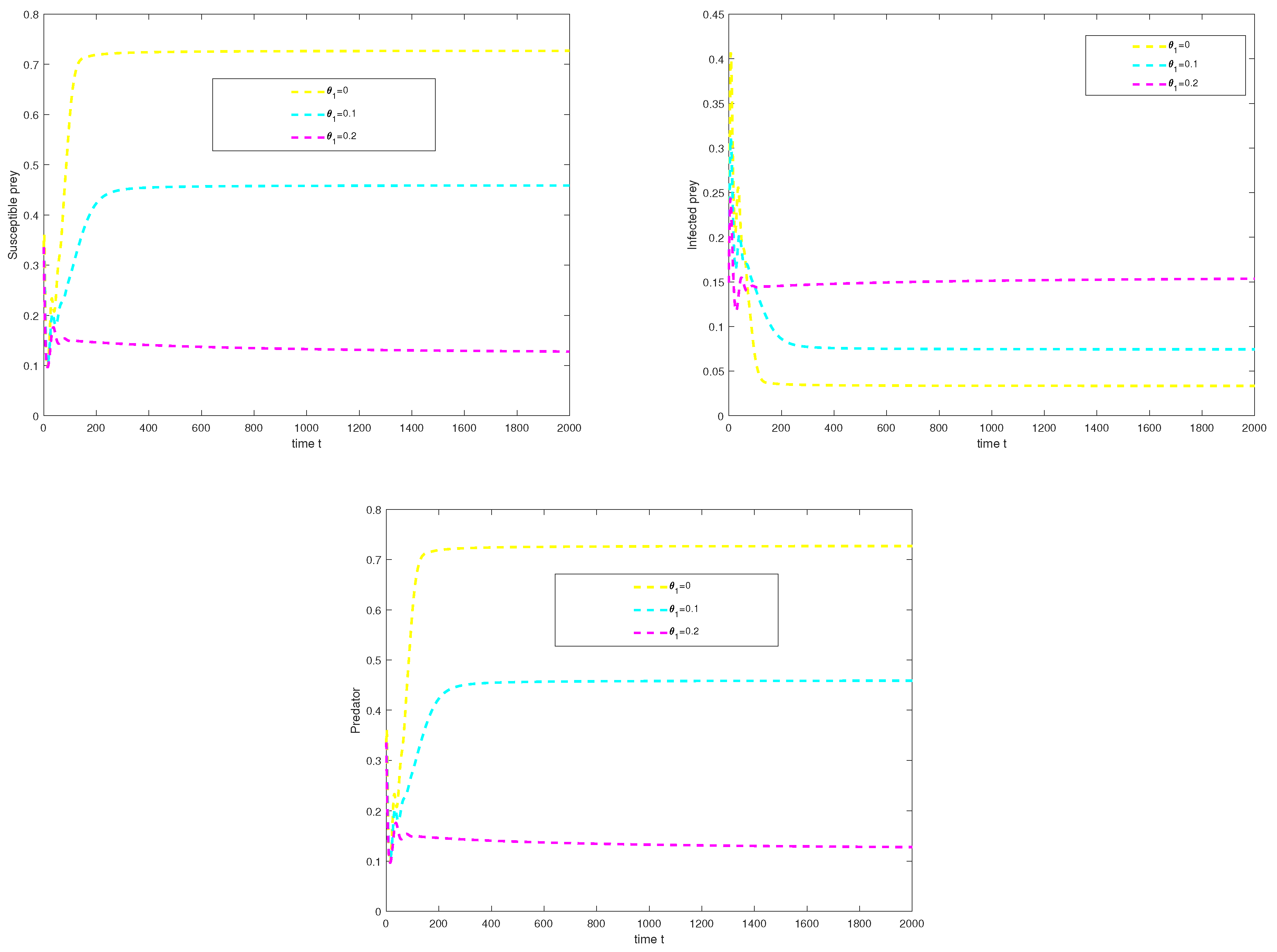Dynamical Analysis of a Fractional Order Prey–Predator Model in Crowley–Martin Functional Response with Prey Harvesting †
Abstract
:1. Introduction
2. Model Formulation
3. Existence and Uniqueness of the Solutions
4. Equilibrium Points and Stability Analysis
- (i)
- The trivial equilibrium point is .
- (ii)
- is the boundary equilibrium point.
- (iii)
- is the infected prey free equilibrium point, where ,.
- (iv)
- is the predator free equilibrium point, where ,.
- (v)
- The interior equilibrium point . Where,and is the unique positive root of the quadratic equation where , , .Now, we want to calculate the Jacobian matrix for a local stability analysis around different equilibrium points. The Jacobian matrix at an arbitrary point is given bywhere, ,, , , ,, , .
5. Numerical Analysis
6. Conclusions
Author Contributions
Funding
Institutional Review Board Statement
Informed Consent Statement
Data Availability Statement
Conflicts of Interest
References
- Lotka, A.J. Elements of Physical Biology; Williams & Wilkins: Philadelphia, PA, USA, 1925. [Google Scholar] [CrossRef]
- Volterra, V. Variazioni e Fluttuazioni del Numero d’Individui in Specie Animali Conviventi; Societa Anonima Tipografica “Leonardo da Vinci”: Citta di Castello, Italy, 1926. [Google Scholar] [CrossRef]
- Kermack, W.O.; McKendrick, A.G. A contribution to the mathematical theory of epidemics. Proc. R. Soc. Lond. Ser. Contain. Pap. Math. Phys. Character 1927, 115, 700–721. [Google Scholar] [CrossRef]
- Ashwin, A.; Sivabalan, M.; Divya, A.; Siva Pradeep, M. Dynamics of Holling type II eco-epidemiological model with fear effect, prey refuge and prey harvesting. In Proceedings of the 1st International Online Conference on Mathematics and Applications, online, 1–15 May 2023; MDPI: Basel, Switzerland, 2023. [Google Scholar]
- Panigoro, H.S.; Suryanto, A.; Kusumawinahyu, W.M.; Darti, I. Dynamics of an eco-epidemic predator–prey model involving fractional derivatives with power-law and Mittag–Leffler kernel. Symmetry 2021, 13, 785. [Google Scholar] [CrossRef]
- Ramesh, P.; Sambath, M.; Mohd, M.H.; Balachandran, K. Stability analysis of the fractional-order prey-predator model with infection. Int. J. Model. Simul. 2021, 41, 434–450. [Google Scholar] [CrossRef]
- Ahmed, E.; El-Sayed, A.M.; El-Saka, H.A. Equilibrium points, stability and numerical solutions of fractional-order predator–prey and rabies models. J. Math. Anal. Appl. 2007, 325, 542–553. [Google Scholar] [CrossRef]
- Stojkoski, V.; Sandev, T.; Kocarev, L.; Pal, A. Geometric Brownian motion under stochastic resetting: A stationary yet nonergodic process. Phys. Rev. E 2021, 104, 014121. [Google Scholar] [CrossRef]
- Yang, W. Dynamical behaviors of a diffusive predator–prey model with Beddington–DeAngelis functional response and disease in the prey. Int. J. Biomath. 2017, 10, 1750119. [Google Scholar] [CrossRef]
- Divya, A.; Sivabalan, M.; Ashwin, A.; Siva Pradeep, M. Dynamics of Ratio dependent eco epidemiological model with prey refuge and prey harvesting. In Proceedings of the 1st International Online Conference on Mathematics and Applications, online, 1–15 May 2023; MDPI: Basel, Switzerland, 2023. [Google Scholar]
- Burov, S.; Jeon, J.H.; Metzler, R.; Barkai, E. Single particle tracking in systems showing anomalous diffusion: The role of weak ergodicity breaking. Phys. Chem. Chem. Phys. 2011, 13, 1800–1812. [Google Scholar] [CrossRef]
- Metzler, R.; Jeon, J.H.; Cherstvy, A.G.; Barkai, E. Anomalous diffusion models and their properties: Non-stationarity, non-ergodicity, and ageing at the centenary of single particle tracking. Phys. Chem. Chem. Phys. 2014, 16, 24128–24164. [Google Scholar] [CrossRef]
- Vinod, D.; Cherstvy, A.G.; Wang, W.; Metzler, R.; Sokolov, I.M. Nonergodicity of reset geometric Brownian motion. Phys. Rev. E 2022, 105, L012106. [Google Scholar] [CrossRef] [PubMed]
- Das, M.; Maiti, A.; Samanta, G.P. Stability analysis of a prey-predator fractional order model incorporating prey refuge. Ecol. Genet. Genom. 2018, 7–8, 33–46. [Google Scholar] [CrossRef]
- Mondal, S.; Lahiri, A.; Bairagi, N. Analysis of a fractional order eco-epidemiological model with prey infection and type 2 functional response. Math. Methods Appl. Sci. 2017, 40, 6776–6789. [Google Scholar] [CrossRef]
- Murray, J.D. Mathematical Biology I: An Introduction; Springer: Berlin/Heidelberg, Germany, 2002. [Google Scholar] [CrossRef]


| Parameters | Biological Representation |
|---|---|
| L | Susceptible prey |
| M | Infected prey |
| N | Predator |
| Intrinsic prey growth rate | |
| K | Carrying capacity of the environment |
| Predation rate of susceptible prey | |
| Predation rate of infected prey | |
| Half-saturation constant | |
| c | Conversion coefficient from the prey to predator |
| Infected prey death rate | |
| Predator population death rate | |
| Infection rate |
Disclaimer/Publisher’s Note: The statements, opinions and data contained in all publications are solely those of the individual author(s) and contributor(s) and not of MDPI and/or the editor(s). MDPI and/or the editor(s) disclaim responsibility for any injury to people or property resulting from any ideas, methods, instructions or products referred to in the content. |
© 2023 by the authors. Licensee MDPI, Basel, Switzerland. This article is an open access article distributed under the terms and conditions of the Creative Commons Attribution (CC BY) license (https://creativecommons.org/licenses/by/4.0/).
Share and Cite
Prabhumani, D.N.; Shanmugam, M.; Manickasundaram, S.P.; Thangaraj, N.G. Dynamical Analysis of a Fractional Order Prey–Predator Model in Crowley–Martin Functional Response with Prey Harvesting. Eng. Proc. 2023, 56, 300. https://doi.org/10.3390/ASEC2023-15975
Prabhumani DN, Shanmugam M, Manickasundaram SP, Thangaraj NG. Dynamical Analysis of a Fractional Order Prey–Predator Model in Crowley–Martin Functional Response with Prey Harvesting. Engineering Proceedings. 2023; 56(1):300. https://doi.org/10.3390/ASEC2023-15975
Chicago/Turabian StylePrabhumani, Deepak Nallasamy, Muthukumar Shanmugam, Siva Pradeep Manickasundaram, and Nandha Gopal Thangaraj. 2023. "Dynamical Analysis of a Fractional Order Prey–Predator Model in Crowley–Martin Functional Response with Prey Harvesting" Engineering Proceedings 56, no. 1: 300. https://doi.org/10.3390/ASEC2023-15975






